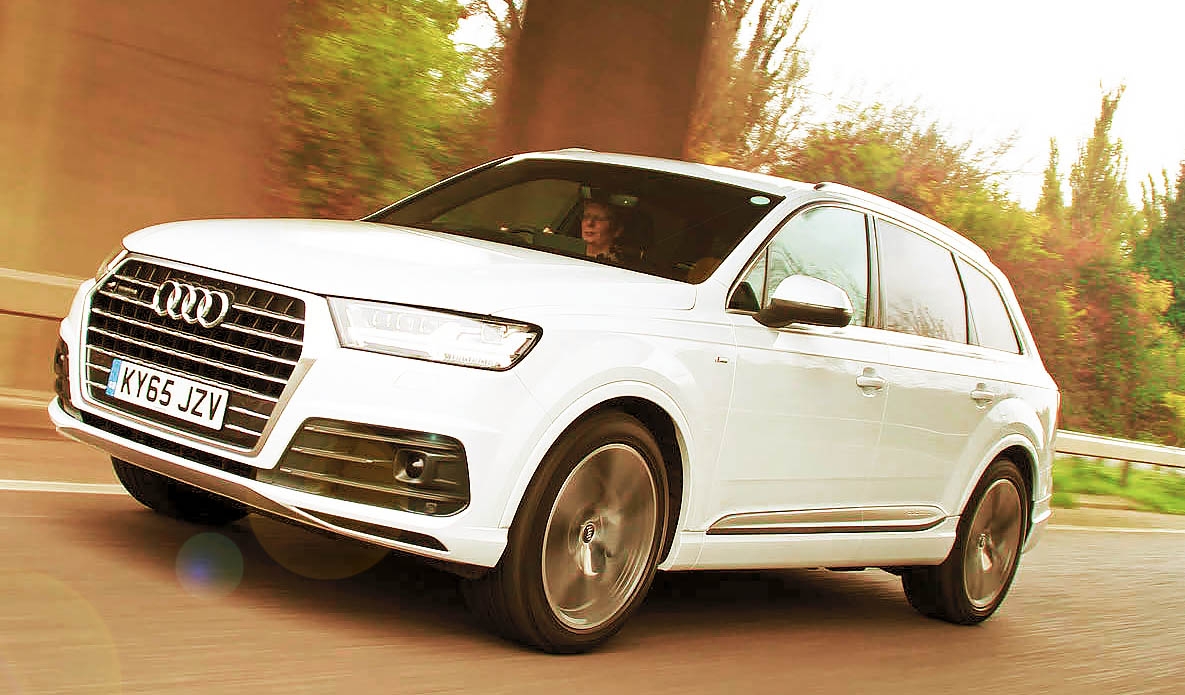
Full road test: 2016 Audi Q7 S line 3.0 TDI (272 PS) Quattro Typ 4M generation. Substantially improved in all areas, the new Q7 comes with better performance and fuel economy as well as superior handling and equipment – this highly specified S line model with the 272 PS 3.0 V6 TDI engine provides an extremely impressive package…
Audi ’s largest SUV, the 7-seater Q7, was first revealed at the Frankfurt Show in September 2005. Designed to rival similar vehicles like the BMW X5 E53, Volvo XC90 and Land Rover Discovery, but with the extra cachet of that famed four-ring logo, the Q7 is almost in a class of its own as far as big high-value SUVs are concerned, with over 500,000 examples sold worldwide since it was first released in 2006.

‘High beam assist, standard on the S line, automatically detects the headlights of oncoming vehicles…’
Built at the Bratislava plant in Slovakia, facelifts in 2009 and 2011 introduced features like restyled front and rear lights and it has been available with a wide range of engines, from 3.6 V6 and 4.2 V8 petrol units to a variety of diesels including 3.0 V6, 4.2 V8 and even a 6.0-litre V12 TDI, developing various power outputs up to 500 PS.
Although never pitched as an all-road vehicle, all models are equipped with four-wheel drive and none have ever had a manual gearbox, with a 6-speed Tiptronic automatic (torque converter ZF6HP) transmission replaced by an 8-speed in 2010 (ZF8HP).
The latest model (as initially reviewed in our June 2015 issue) is the second generation, based on the new MLB platform, and powered by a choice of 333 PS 3.0 V6 TFSI petrol and 218 or 272 PS 3.0 V6 TDI diesel engines, with a 373 PS plug-in Hybrid e-tron version recently released although it doesn’t look as though we’ll get the 3.0 V6 TFSI here in Britain.

‘Dynamically, the Q7 is very competent for such a large vehicle…’
While the previous Q7 was big, powerful and imposing, almost brutal in its styling – a heavyweight in terms of both appearance and sheer physical mass – the new Q7 Typ 4M, while just as large and accommodating inside, is much more elegant and attractive in appearance – looking more like an enlarged estate car than a leviathan SUV.
| Maximum speed | 145 mph, 233,7 kph |
| 0–50 mph |
4.9 sec |
| 0–60 mph | 6.4 sec |
| 0–70 mph |
8.5 sec |
| 0–80 mph |
10.9 sec |
| 30–50 mph (3rd gear) |
2.6 sec |
| 30–50 mph (4th gear) | – |
| 50–70 mph (3rd gear) |
3.6 sec |
| 50–70 mph (4th gear) | – |
| 50–70 mph (5th gear) | – |
| 50–70 mph (6th gear) | – |
| road speed/1000 rpm in top gear |
47.9 mph, 75.5 kph |
It is, in fact, very slightly smaller in overall dimensions; shorter by some 37 mm (1.5 inches) in overall length and reduced by 15 mm in width, with the wheelbase slightly shorter (by 8 mm). It’s fractionally taller, by 3 mm, but that’s hardly significant. Even so, its use of space inside has been improved, with increased shoulder width (+23 mm in the front) and headroom (+41 mm) for both front and second row passengers. There is no change in space for the two rearmost seats, but the usable luggage space is significantly improved.
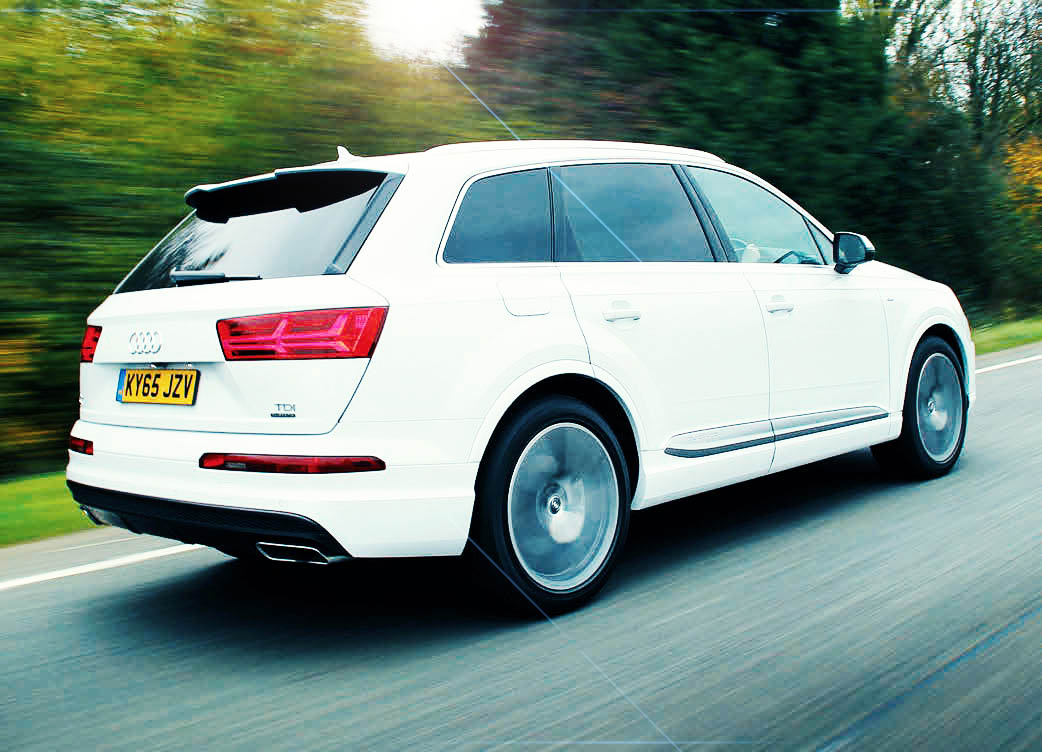
‘In-gear response is also very strong, with the 8-speed auto kicking down readily to pick up and punch forwards…’
Using the latest generation of platform engineering, the new Q7 is based on the lighter and more versatile modular longitudinal platform (MLB) with an advanced aluminium and steel composite bodyshell. Along with the use of lighter suspension components and other weight-saving measures the total weight has been reduced by 240 kg compared with its 7-seater predecessor, and as much as 325 kg when the rearmost seating is deleted (a no-cost option). So, considerably reduced in weight – the equivalent, we are told, of a grand piano – and with enhanced engine performance, it is clearly capable not only of superior performance and fuel-efficiency but also improved handling, thanks to the improvement in power to weight ratio and reduced momentum.
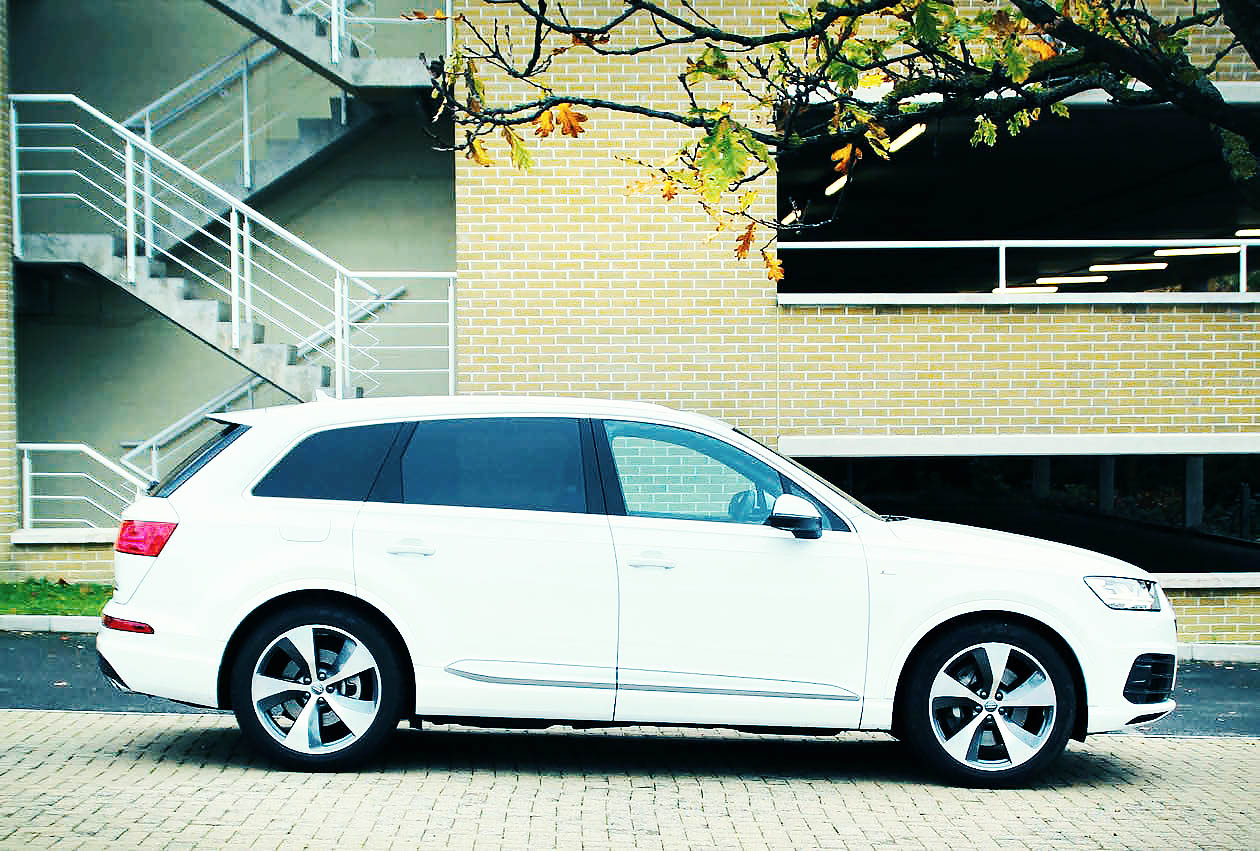
‘Powering the new Q7 for the UK market is a new and extensively improved 3.0-litre V6 TDI engine…’
While also more conservative in its visual weight, the styling is certainly still distinctive, its frontal features dominated by a large threedimensional hexagonal single-frame grille with double-arrow shaped running lights, a greater overall emphasis on horizontal styling lines and the addition of quattro sideblades along the flanks, with a full body-colour finish now standard.
There are just two trim levels to choose between: SE or S line, with the SE currently priced at £50,340 OTR and the S line at £53,835 OTR.
SE provides standard equipment such as Xenon Plus headlights, LED DRLs and tail lights, drive select adaptive dynamics, 8.5 x 19-inch alloys with 255/55 R19 tyres, 4-spoke multifunction steering wheel, MMI navigation plus with touchsensitive MMI screen, electrically adjustable front seats, Audi Sound System, dual-zone climate control, MMI radio Plus and DAB, Audi Music Interface and Bluetooth phone preparation, Audi Connect with 3-month trial of online services, colour driver information system (DIS) and 7 leather-trimmed seats as standard. S line adds all-weather LED headlights with High Beam Assist, 9.0 x 20-inch alloys with 285/45 R20 tyres; S line front bumper, grilles, side skirts and rear spoiler, 3-spoke S line multifunction steering wheel, front sports seats with leather/Alcantara upholstery, privacy glass for rear and rear side windows, brushed aluminium dash inlays, 4-zone climate control and dynamic sweeping rear indicators.
Our test vehicle, finished in Glacier white metallic (+£675) with Black Valcona leather interior (+£1100) was the S line but with a whole host of expensive optional extras that bumped the total price up to £72,060!
Powering the new Q7 for the UK market is a new and extensively improved 3.0-litre V6 TDI engine, with a choice of two power outputs. The lower-powered but more fuel-efficient version of the 3.0 V6 TDI, with 218 PS and 500 Nm, is claimed to be capable of 0-62 mph in 7.4 seconds and a top speed of 134 mph, with an NEDC fuel economy figure of 52.3 mpg and CO2 emissions of 144 g/km.
The higher-powered version, as tested here, produces 272 PS between 3250 and 4250 rpm and 600 Nm (442.5 lb.ft) of torque from 1500 to 3000 rpm through the use of variable turbine geometry and a more efficient combustion process due to improvement of swirl and flow rates in the induction system.
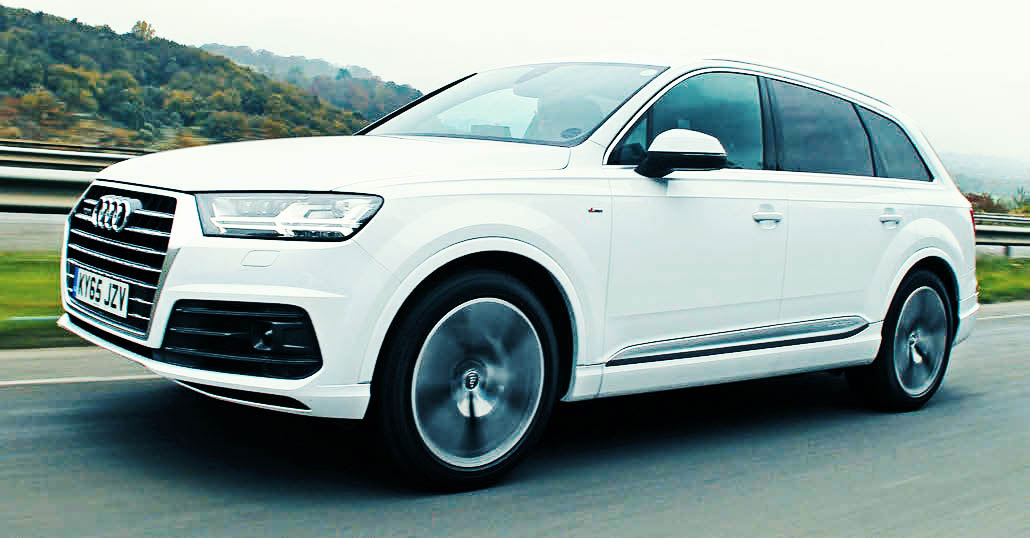
’The new Audi Q7 is much more elegant and attractive in appearance…’
Both these engines have SCR (selective catalytic reduction), using AdBlue injection to reduce NOx emissions, and along with reduced internal friction and improved thermal management both are EU-6 compliant, with a combined cycle fuel economy figure of 47.9 mpg and CO2 emissions of 153 g/km for the 272 PS 3.0 TDI.
Compared with its 245 PS predecessor, it produces 11 per cent more power and 27.5 per cent less CO2, with its acceleration to 62 mph improved by 1.3 seconds and top speed increased by 10 mph.
Used in conjunction with an 8-speed automatic transmission that has asymmetrically split torque control in the four-wheel drive system (normally 40:60 front to rear, but variable up to 85 per cent rear or 70 per cent front), it is claimed to be capable of accelerating from 0-62 mph in 6.5 seconds and a top speed of 145 mph. Our own performance figures bear this out, for outright performance when driven solo, with a 0-60 mph time of 6.4 seconds, and 70 and 80 mph coming up in 8.5 and 10.9 seconds respectively.
| Audi Q7 3.0 TDI (218 PS) SE | £47,755 |
| Audi Q7 3.0 TDI (218 PS) S line | £51,250 |
| Audi Q7 3.0 TDI (272 PS) SE | £50,340 |
| Audi Q7 3.0 TDI (272 PS) S line | £53,835 |
| Audi Q7 e-tron 3.0 TDI Plug-in hybrid | £To be confirmed |
| Audi Q7 SE 3.0 TDI quattro 272 PS 8-speed tiptronic | £50,340 |
| Audi Q7 S line 3.0 TDI quattro 272 PS 8-speed tiptronic | £53,835 |
In-gear response is also very strong, with the 8-speed auto kicking down readily to pick up and punch forwards, not quite as instantaneously as a dual-clutch (S tronic) auto but plenty fast enough to maximise the opportunity for a swift overtake. In any case, you can use the shifter in tiptronic mode to pre-select a lower gear or flick it down a ratio using the paddle shifters on the steering wheel.
The 8-speed auto also now incorporates an automatic freewheeling function, similar to that which we’ve seen on the 6-speed DSG / S tronic transmissions, allowing the Q7 to coast on the over-run or to shed engine speed under braking. With the aid of energy recuperation and stop/ start system as well as the inherent efficiency of the new V6 TDI, it is capable of quite reasonable fuel economy for a vehicle of its size.
We recorded just under 35 mpg as a genuine overall average and achieved nearly 46 mpg when driving deliberately for maximum economy, cruising at a steady 60 mph on the motorway. With the high gearing of the 8-speed transmission giving nearly 48 mph per 1000 rpm, even at 80 mph that’s little more than tickover and just inside the broad torque band, with the engine speed low enough for good fuel efficiency but still capable of responding readily when required.
Note from our performance comparison table that Audi quotes different figures for fuel economy and emissions when running on the (optional) larger 9.5 x 21-inch wheels and tyres, as fitted here, so you could quite reasonably expect to see another 2 or 3 mpg on those figures if using the standard-fit 9.0 x 20-inch alloys.
The standard fuel tank capacity is 75 litres, but there is also an 85-litre tank available as an option costing £115 for anyone who feels the need for an extended range for long-distance driving; that extra 10 litres would allow for an additional 70 to 100 miles, or provide for full use of the performance, depending on driving style.
Dynamically, the Q7 is very competent for such a large vehicle, especially so with the high driving position providing an excellent view of the road ahead. The suspension incorporates a newly-developed 5-link rear suspension for improved driving dynamics, with the standard set-up using coil springs, while the optional (£2,000) adaptive air suspension, as fitted to our test car, works constantly to keep the vehicle level at all times, reducing pitch and roll to a minimum. It also has an allroad and lift/allroad function that raises the chassis by 25 and 60 mm respectively, improving ground clearance for moderate off-road use, as well as increasing the trailer load capacity to 3500 kg. The Q7 also has hill hold assist for the electronic handbrake and a hill descent program.
Also among the optional features on our test car was rear-wheel steering (£1100), for improved agility at low speeds and greater stability at higher speeds. It’s difficult to fully assess the dynamic advantage without testing two examples, with and without, in a direct back-to-back evaluation, but there’s little doubt that this will provide a handling advantage. Also, with the rear wheels turning by up to 5 degrees in the opposite direction to the fronts during low-speed manoeuvres, it cuts the turning circle by a full one metre compared with the 12.4 metres of the standard vehicle.
Audi Drive Select is standard on the Q7, integrating with the engine and transmission so that the operating characteristics can be adjusted over five modes – auto, comfort, efficiency, dynamic or individual. It affects the engine and transmission response as well as the action of the electromechanical steering and, if the optional adaptive air suspension is fitted, it also adjusts the suspension to suit the style of driving.
In Dynamic mode, the big Q7 instantly feels more alert and responsive, the suspension firmer but not harsh. Auto is undoubtedly the desirable default position, with Comfort just that little bit too soft and underdamped for anything other than slow speeds over rough roads, or maybe steady state cruising on the motorway in still conditions. In the Individual setting, though, you can mix and match between settings on individual parameters; for instance, selecting a firm Sports setting for the steering while using Auto for the suspension and Comfort for the engine and transmission.
Although it has never really been pitched as an off-road vehicle, the Q7’s quattro all-wheel drive system is more than capable of moderate off-road use and will certainly never be found lacking for traction in any type of road use. The drive ratio is normally 40:60 front to rear, but is variable up to 85 per cent rear or 70 per cent front, with the Pirelli Scorpion Verde ultra high-performance tyres on our test vehicle also available in an allseasons version if you are planning to use the Q7 in a more rural environment.
Certainly, in conjunction with the variable height function of the optional air suspension, the Q7 would make a great high-class recreational vehicle with excellent towing ability; ideal perhaps for lugging a horsebox or caravan, or for use as a hot-air balloon retrieve vehicle. Our test car had the Trailer pack (£1300) which provides an electrically folding towball (operated by a switch inside the load space), includes stabilisation through the ESC system and provides Trailer Assist which aids manoeuvring when reversing with a trailer.
It certainly has plenty of carrying capacity, with usable luggage space significantly improved from 330 / 2035 litres to 770 / 1955 litres, compared to its predecessor, and offering more luggage space than nearly all other competitors in its class. The loading sill is also 48 mm (almost 2 inches) lower than its predecessor and the tailgate has a wide opening and is now poweroperated on all versions. There’s also a button to raise and lower the air suspension when loading heavy items and the S line model comes with a stainless-steel sill protection strip as standard. The options list also includes a rear net partition, a load area fixing kit which provides a telescopic bar and securing belt for dividing up and securing luggage in the rear load space, a reversible mat which folds out to cover the whole load area and even an electrically operated luggage compartment cover.
The versatility of seating and load space is also much improved with this new model, with the second row seating (35:30:35) now having a tilt and fold function, each being individually adjustable, and the two rearmost seats (50:50) now have an electric power folding mechanism. Operated from switches in either side of the rear load compartment, or on the rear door jambs, they automatically fold down flat into the floor; even folding the headrests down as they go.
Those rearmost seats are primarily for children; although smaller adults would be comfortable enough for short journeys, it can be a bit of a clamber to get in and out past the second row seats which fold and tip forwards. Equipped with ISOFIX attachments, child seats can be fitted in all six passenger seat locations if required.
Interior equipment and technology includes MMI navigation Plus with MMI Touch, Audi connect, Audi drive select and keyless start, while options include the digital virtual cockpit dash display, high-quality audio systems from Bose and Bang & Olufsen, Audi tablet for the rear seat passengers and numerous advanced driver assistance systems. Our test car came with the Bose 3D sound system, priced at £1,100, which provides crystal clear sound reproduction throughout the front part of the cabin. You can improve on it with the Bang & Olufsen 3D system, which is claimed to provide concert hall acoustics, but that costs a very substantial £6,300!
In the new Q7, the Audi Connect portfolio, with a 3-year subscription, also provides a new smartphone interface that brings Apple Car Play and Google Android Auto on board; if an iOS or Android phone is connected to the USB port the respective environment opens in the Audi smartphone interface, both tailored for use in the car and with online music at its heart, as well as navigation functions, missed call or appointment reminders and messaging functions. It is part of a technology pack, priced at £1,950, that also includes Audi virtual cockpit, head-up display, Audi phone box and High-beam assist.
Similar to the system in the new TT, the Audi virtual cockpit is essentially a digital dashboard that replaces the analogue instrumentation with a high-resolution (1440 x 540 pixel LCD) 12.3-inch TFT display. Controlled from the multifunction steering wheel, voice-control technology or the MMI Touch, it can be switched between a conventional-looking twin instrument arrangement with prominent speedo, tacho and gear indicator, and an infotainment view that provides an increased display area between the reduced size instruments, allowing greater scope and detail for lists and mapping.
‘Our test vehicle was the Audi-S line but with a whole host of expensive optional extras that bumped the total price up to £72,060!’
Audi phone box allows the use of a mobile phone in the car simply by placing it into the storage compartment in the front centre armrest where it receives a wireless connection from the car’s aerial, to improve reception quality.
High beam assist, standard on the S line, automatically detects the headlights of oncoming vehicles, or the tail lights of a car ahead, and switches the main beam on or off accordingly. As well as the usual comprehensive array of dynamic and passive safety systems, the Q7 now also comes with pre-sense city and pre-sense basic as standard. Pre-sense city uses a forwardfacing camera and operates at lower speeds to warn of an imminent collision before instigating emergency braking if required, while pre-sense basic operates in the event of a collision; tightening the seat belts and closing the windows and sunroof, as well as using controlled braking to mitigate additional collisions that might otherwise result.
The new Q7 also comes with the availability of a bewildering array of driver assistance systems. Traffic jam assist, an evolution of the adaptive cruise control (ACC), can take over both the steering and fore and aft modulation, providing almost autonomous driving by controlling the braking and accelerator in heavy stop and go traffic situations, at speeds below 37 mph. Above that speed, Active lane assist also detects lane markings and uses gentle steering intervention to keep the car in lane, useful on the motorway for instance.
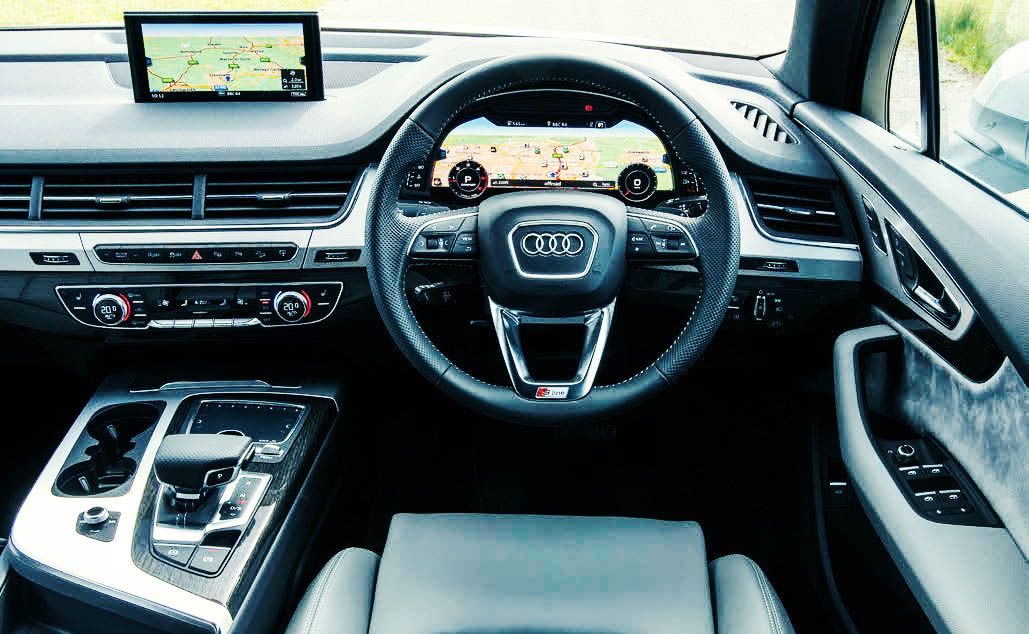
1: Display screen / 2: Temp gauge / 3: Digital dash / 4: Fuel gauge / 5: Drive select / 6: DIS controls / 7: Phone controls / 8: Climate control / 9: Cruise control / 10: MMI Touch / 11: Electronic p/brake
Predictive efficiency assistant uses the route data from the satnav as well as traffic sign recognition and adaptive cruise control to advise the driver when it might be beneficial to reduce speed in the interests of fuel efficiency, when approaching bends or areas with reduced speed limits, while also controlling the freewheel function in the 8-speed automatic gearbox.
Other advanced driver aids range from automatic steering control for parallel and perpendicular parking (both backwards and forwards), also helping the driver when exiting from a tight parking space, and an automatic alert system to warn of oncoming traffic when reversing out of a parking space, or when pulling out of a junction, while a turn assist system monitors oncoming traffic when the vehicle is about to turn across traffic at a busy junction, and will warn and ultimately stop the Q7 if it is about to turn in front of a vehicle approaching at too high a speed, if a collision is considered imminent.
| CAR | Q7 3.0 TDI quattro 8-spd tiptronic Typ 4M | Q7 3.0 TDI CD quattro 6-spd tiptronic Typ 4L | Q7 3.0 TDI quattro 6-spd tiptronic Typ 4L | Q7 3.6 FSI quattro 6-spd tiptronic Typ 4L | VW Touareg Altitude 3.0 V6 TDI 4Motion 8-spd tiptronic |
| Displacement, cc | 2967 | 2967 | 2967 | 3597 | 2967 |
| Power output, PS/kW | 272/200 | 240/178 | 233/171 | 280/207 | 245/180 |
| @ rpm | 3250-4250 | 4000-4400 | 4000 | 6200 | 3800 |
| Maximum torque, lb.ft./nm | 442/600 | 407/550 | 375/500 | 266/360 | 406/550 |
| @ rpm | 1500-3000 | 2000-2250 | 1750-2750 | 2500-5000 | 1750 |
| Maximum speed, mph/kph | 145/233 | 134/215 | 134/215 | 142/228 | 137/220 |
| 0–50 mph, sec | 49 | 65 | 68 | 59 | 56 |
| 0–60 mph, sec | 64 | 84 | 92 | 84 | 75 |
| 0–70 mph, sec | 85 | 109 | 121 | 108 | 101 |
| 0–80 mph, sec | 109 | 146 | 151 | 132 | 139 |
| 30–50 mph (third gear), sec | 26 | 38 | 37 | 33 | 32 |
| 30–50 mph (fourth gear), sec | – | – | – | – | – |
| 50–70 mph (third gear), sec | 36 | 60 | 52 | 50 | 50 |
| 50-70 mph (fourth gear) sec | – | – | – | – | – |
| 50–70 mph (fifth gear), sec | – | – | – | – | – |
| 50–70 mph (sixth gear), sec | – | – | – | – | – |
| overall consumption, mpg / l/100km | 34.7/8.1 | 26.5/10.7 | 23.2/12.2 | 17.9/15.8 | 34.4/8.2 |
| Unladen weight, lb/kg | 4541/2060 | 5237/2375 | 5127/2325 | 4928/2235 | 4746/2153 |
| Power/weight PS/ton, PS/tonne | 134/132 | 103/101 | 102/100 | 127/125 | 115/113 |
| Test publication date | Jan 2016 | Mar 2010 | Oct 2006 | Apr 2008 | Mar 2013 |
A similar camera-operated system also scans for pedestrians or vehicles that might suddenly emerge from amongst parked cars at the side of the road and will initially warn and if necessary apply the brakes if the driver fails to act quickly enough. At low speeds it can completely avoid a collision; at higher speeds it will substantially mitigate the impact.
For the occupants, an exit warning system monitors the rear and sides of the vehicle and flashes the blind-spot indicators as well as an illuminated strip in the door trims if they are about to open the door in the face of oncoming traffic. Clearly, the new Q7 is a highly sophisticated and competent all-rounder, with its basic drivetrain format and technical design complemented by an almost bewildering array of technological advances, available either as standard or optional equipment.
Whether anyone will really need all these facilities on a regular basis, or indeed whether they will often require the services of a full sevenseater SUV with exemplary road manners as well as moderate off-road ability is questionable. However, compared with the huge cost of an R8 V10 plus which can only seat two people and carry minimal luggage between the race track venues where you can only ever fully exploit the full performance, the Q7 can be regarded as a veritable bargain for its comprehensive all-round abilities and will be considerably more economical on a long journey!
| Displacement 2967 cc |
| Configuration V |
| Cylinders 6 |
| Bore and stroke 83.0 x 91.4 mm |
| Power output 272 PS (200 kW) @ 3250-4250 rpm |
| Maximum torque 442 lb.ft. (600 Nm) @ 1500-3000 rpm |
| Compression ratio 16.0 :1 |
| Valves per cylinder 2 inlet, 2 exhaust |
| FUEL CONSUMPTION |
| overall test value 34.7 mpg, 8.1 l/100km |
| Economical driving 45.8 mpg, 6.2 l/100km |
| Urban cycle 44.1/42.2* mpg, 6.4/6.7* l/100km |
| Extra urban cycle50.4/47.1 mpg, 5.6/6.0* l/100km |
| Total47.9/45.6 mpg, 5.9/6.2* l/100km |
| Fuel required Diesel to EN590 |
| Fuel tank capacity 16.5 gallons, 75 litres |
| CO2 emission 153/163* g/km |
| * On 21-inch wheels |
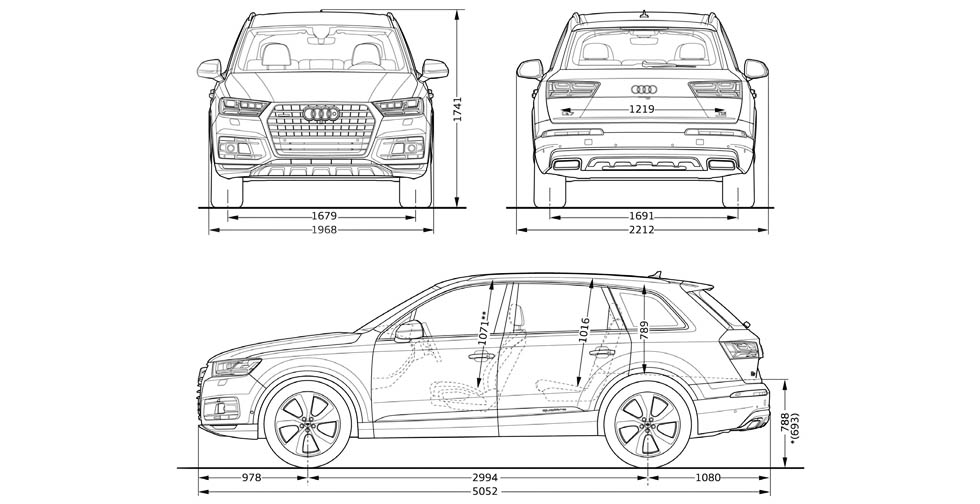
| Turning circle 40.7/37.4* ft, 12.4/11.4* m | |
| Unladen weight 4541 lb, 2060 kg | |
|
Total permitted weight 6481 lb, 2940 kg Permitted trailer load; w brakes 6172/7716** lb, 2800/3500** kg Permitted trailer load; w/out brakes 1653 lb, 750 kg |
|
| Luggage capacity (seats up/folded) 770/1955 litres | |
| Wheels and tyres 9.0J x 20 alloys 285/45 R20† | |
|
* Standard/with rear axle steering **With air suspension † 9.5 x 21 285/40/R21 on test car |





